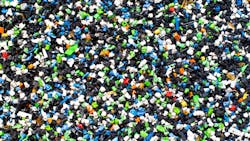Rivers contain hidden sinks, sources of microplastics
New research finds significant quantities of microplastic particles are being trapped in riverbed sediments or carried through the air along major river systems, according to a press release from the University of Plymouth.
The research, conducted along the length of the Ganges River in South Asia, found on average about 41 microplastic particles per square meter per day settled from the atmosphere.
In addition, analysis by scientists found 57 particles per kilogram on average in sediment from the riverbed as well as one particle in every 20 liters of water.
The research, published in Science of the Total Environment, represents the first combined analysis of microplastics in water, sediment and air around a major river system.
It was conducted using samples collected by an international team of scientists as part of the National Geographic Society's Sea to Source: Ganges expedition.
“We have known for some time that rivers are key pathways for the transfer of microplastics to marine environments,” said Imogen napper, lead author and a research fellow at the University of Plymouth. “However, there has always been uncertainty about the sheer amounts being transported, and whether they represent long-term sinks. This study goes some way to unravelling that mystery, and revealing the true scale of microplastic contamination that our river systems can represent.”
Many of the same scientists were involved in a previous study, published in January 2021, which suggested the Ganges River and its tributaries could be responsible for up to 3 billion microplastic particles entering the Bay of Bengal every day.
In addition to highlighting the overall abundance of particles, for the new study scientists found fibers to be the most common type, representing up to 99% of the microplastics discovered in some of the samples analyzed.
Within this, rayon (synthetically altered cellulose) was the dominant polymer — representing up to 82% of the fibers found in some samples — ahead of acrylic and polyester, and blue was the most common color.
The sediment samples often contained denser microplastic particles than those found in water and air, and higher population densities correlated with increased microplastic abundance for air and water samples.
Writing in the study, scientists say they believe clothing is likely to be the prominent source of microplastics to this particular river system, influenced by atmospheric deposition, wastewater, and direct inputs such as the handwashing of clothes in the Ganges.


